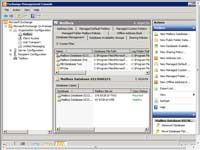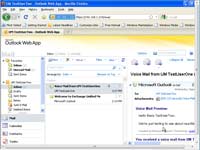Product Reviews
What's New in Exchange Server 2010
Boasting a new and rich set of technologies, does it deliver?
It's easy to find a list of new features for Microsoft's latest messaging platform release. There's even a complete bullet-by-bullet example from Microsoft. Some of these new features, however, merit more attention than appearing in a bulleted list.
Storage Improvements
There have been some dramatic adjustments in storage architecture that allow for greater flexibility and higher performance. For example, Microsoft boasts an additional 50 percent to 70 percent reduction in disk I/O from Exchange 2007. What this ultimately means is you won't necessarily need additional disks to retain performance levels for your organization. Affordable disk flexibility is interesting, but even more interesting is the fact that Exchange 2010 allows for a new form of high availability (HA) that may eliminate the need for more expensive RAID solutions in some organizations.
Starting with Exchange 2007, HA solutions used continuous replication to ship the transaction logs over to another disk, system or -- with SP1 -- another site, and replay into the duplicate database. These HA solutions were called Local, Cluster and Standby Continuous Replication (LCR, CCR and SCR). The configuration required you to put a single database within a single storage group for this to work properly -- which made sense considering the fact that multiple databases within a storage group would create a mixed set of transaction logs. The solution in 2007 was to tell administrators to put one database in one storage group. In Exchange 2010, the solution is to remove storage groups altogether. Now, the focus is simply on the database itself.
How does this affect HA? With Exchange 2010, all the previous HA solutions are gone. LCR, CCR, SCR, even SCC -- Single-Copy Clusters, which are a throwback to earlier HA solutions for Exchange -- have been removed in favor of Database Availability Groups (DAGs). DAGs are easy to configure and reminiscent of a fault-tolerant solution for disks.
The excitement that comes with a DAG for an admin is that you can create up to 16 different replicas of your database across multiple servers or sites. (Figure 1 shows two replicas across two mailbox servers that are DAG members.) And you don't need an expensive RAID solution in place, although there are obvious costs involved with the increased hardware, software and required disk space for replicas on each server.

[Click on image for larger view.] |
| Figure 1. Database replicas across two mailbox servers. |
UM Enhancements
As for the maturing of Unified Messaging (UM), the latest version in Exchange 2010 has some new features that are bound to impress. For example, a user can now create up to nine call -- answering rules that achieve call -- answering behavior enhancements. This provides a personal auto attendant for the user's mailbox that can transfer the call to another UM-enabled user, voice mail, another number and so forth.
In addition, there are more language-support features, improvements to name lookup from a caller ID and a new message-waiting-indicator support feature. This feature is found in many legacy voice mail systems -- you may have a blinking light of sorts that indicates you have a voice mail -- and in Exchange 2007, was provided by a third-party solution. Now, it's added to Exchange 2010.
The converse of that is the lack of built-in support for incoming faxes, which was included in Exchange 2007 but has been removed in Exchange 2010. Now you have to use a fax partner solution, which, at the time of this writing, is only available from Concord Fax from Concord Technologies, though others will soon become fax partners. A fax partner solution will provide for a more robust experience than what we had with Exchange 2007. In addition, most of these providers have a form of outgoing fax service that wasn't included with 2007.
One of my favorite new features in UM is the ability to have a voice mail preview. Personally, I hate voice mail. It slows me down. I'd prefer a person e-mailed me if they couldn't reach me by phone. Providing UM -- in which my voice mail is now seen in my inbox -- is a step in the right direction, certainly, but having that voice mail translated to text in a best-guess manner is absolutely awesome. I say "best guess," but in
actuality, UM uses Automatic Speech Recognition technology to provide that "guess," and the results are impressive. Through Outlook or Outlook Web Access, you'll be able to either hear an MP3 of your voice mail or see the translation (shown in Figure 2). One neat feature works with Outlook 2010 so that you can click anywhere in the voice mail and it'll play from that point.

[Click on image for larger view.] |
| Figure 2. Viewing a voice mail preview through Outlook Web Access. |
Role-Based Permissions
Smaller organizations may not immediately see the value of a new permissions structure. However, larger organizations may have a variety of administrators that handle different roles of administration. Adjusting the permissions model from what we have in 2007 with Exchange allows for a more precise -- or broad, depending on what you need -- set of permissions based on the roles of your administrators. You can add or remove administrators from role groups, and then add or remove various role assignments from a particular role group to better control the amount of authority a person or group of people has.
Beyond Role-Based Access Control (RBAC), there are new management-role assignment policies that define what users can configure in terms of their own mailboxes. Every mailbox has one of these policies -- either a default or manually configured one -- that allows administrators to control how much a user can change personal information, contact information, distribution group membership and more.
| REDMOND RATING |
|
Installation 20% |
9.0 |
|
Features 20% |
10.0 |
|
Ease of use 20% |
9.0 |
|
Administration 20% |
9.0 |
|
Documentation 20% |
8.0 |
|
Overall Rating: |
9.0 |
Key: 1: Virtually inoperable or nonexistent 5: Average, performs adequately 10: Exceptional | | |
Both the new RBAC permission structure and the new management-role assignment policies will make controlling your Exchange organization easier and -- when necessary -- more detailed.
Does It Deliver?
Exchange Server 2010 is absolutely an improvement. Having personal contact with the Exchange team and seeing the development process from the inside out certainly makes me a bit biased in favor of anything that comes out relating to Exchange. However, having already put in extensive time with the new Exchange Server 2010, I can also truly say that I've seen this product bake to completion. I've witnessed the effort and the testing put in to make sure it's a solid reflection of what clients want in their next version of the widely deployed messaging solution we call Exchange.
Exchange Server 2010
Microsoft has not yet announced pricing
Microsoft Corp.
425-882-8080
www.microsoft.com
About the Author
J. Peter is a Microsoft MVP (Office Servers and Services) and has received this award for 7 consecutive years. He's an internationally published author and technical speaker. J. Peter is a technical journalist for InfoWorld and has cared for the Enterprise Windows column for nearly a decade. He's the co-founder of both ClipTraining and Conversational Geek and a strategic technical consultant for Mimecast. Follow him on Twitter @JPBruzzese